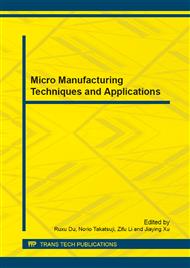[1]
Z. A. Samah, Integration of Nanostructured Titania into microsystems, Ph.D., Materials, University of California, Santa Barbara, USA, (2005).
Google Scholar
[2]
X. Huang, R. W. Pascal, K. Chamberlain, C. J. Banks, M. Mowlem, and H. Morgan, A Miniature, High Precision Conductivity and Temperature Sensor System for Ocean Monitoring, Sensors Journal, IEEE, vol. 11, pp.3246-3252, (2011).
DOI: 10.1109/jsen.2011.2149516
Google Scholar
[3]
H. Tang, K. Prasad, R. Sanjinés, and F. Lévy, TiO2 anatase thin films as gas sensors, Sensors and Actuators B: Chemical, vol. 26, pp.71-75, (1995).
DOI: 10.1016/0925-4005(94)01559-z
Google Scholar
[4]
O. K. Varghese, D. Gong, M. Paulose, K. G. Ong, E. C. Dickey, and C. A. Grimes, Extreme Changes in the Electrical Resistance of Titania Nanotubes with Hydrogen Exposure, Advanced Materials, vol. 15, pp.624-627, (2003).
DOI: 10.1002/adma.200304586
Google Scholar
[5]
Y. Cui, L. J. Lauhon, M. S. Gudiksen, J. Wang, and C. M. Lieber, Diameter-controlled synthesis of single-crystal silicon nanowires, Applied Physics Letters, vol. 78, p.2214, (2001).
DOI: 10.1063/1.1363692
Google Scholar
[6]
J. Kong, H. T. Soh, A. M. Cassell, C. F. Quate, and H. Dai, Synthesis of individual single-walled carbon nanotubes on patterned silicon wafers, Nature, vol. 395, pp.878-881, (1998).
DOI: 10.1038/27632
Google Scholar
[7]
G. Tang, J. Chen, Fabrication of nanostructured titania thin film at low temperature, in The 9th International Conference on Solid-State and Integrated-Circuit Technology, Beijing, China, 2008, pp.2593-2596.
DOI: 10.1109/icsict.2008.4735103
Google Scholar
[8]
Z. A. Samah, Microfabricated Structures and Devices Featuring Nanostructured Titania Thin Film, Ph.D., University of California, Santa Barbara, USA, (2007).
Google Scholar
[9]
T. Choudhury, S. O. Saied, J. L. Sullivan, and A. M. Abbot, Reduction of oxides of iron, cobalt, titanium and niobium by low-energy ion bombardment, Journal of Physics D: Applied Physics, vol. 22, p.1185, (1989).
DOI: 10.1088/0022-3727/22/8/026
Google Scholar
[10]
D. Gonbeau, C. Guimon, G. Pfister-Guillouzo, A. Levasseur, G. Meunier, and R. Dormoy, XPS study of thin films of titanium oxysulfides, Surface Science, vol. 254, pp.81-89, (1991).
DOI: 10.1016/0039-6028(91)90640-e
Google Scholar


